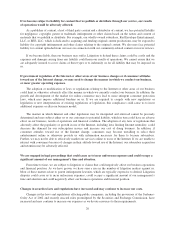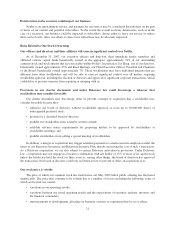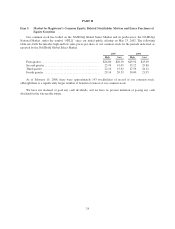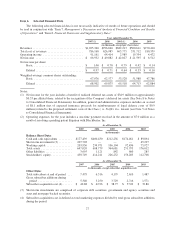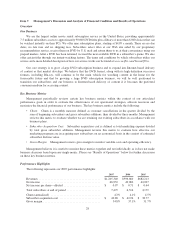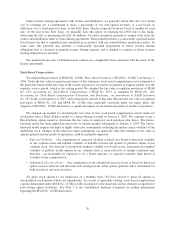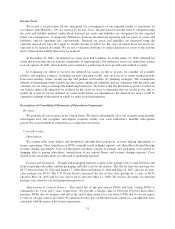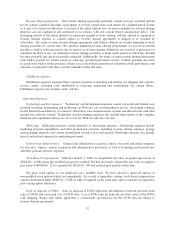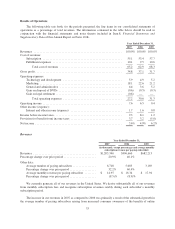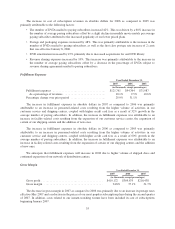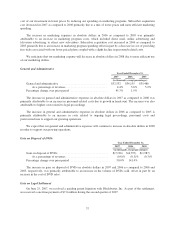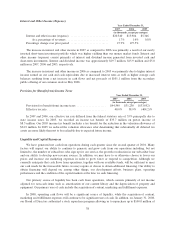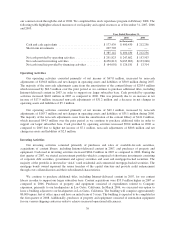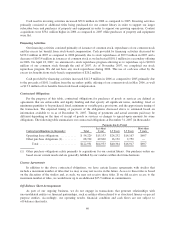NetFlix 2007 Annual Report Download - page 35
Download and view the complete annual report
Please find page 35 of the 2007 NetFlix annual report below. You can navigate through the pages in the report by either clicking on the pages listed below, or by using the keyword search tool below to find specific information within the annual report.Under revenue sharing agreements with studios and distributors, we generally obtain titles for a low initial
cost in exchange for a commitment to share a percentage of our subscription revenues or a fee based on
utilization over a fixed period of time, or the Title Term, which is typically between 6 and 12 months for each
title. At the end of the Title Term, we generally have the option of returning the DVD title to the studio,
destroying the title or purchasing the title. In addition, we remit an upfront payment to acquire titles from the
studios and distributors under revenue sharing agreements. This payment includes a contractually specified initial
fixed license fee that is capitalized and amortized in accordance with our content library amortization policy. In
some cases, this payment also includes a contractually specified prepayment of future revenue sharing
obligations that is classified as prepaid revenue sharing expense and is charged to expense as future revenue
sharing obligations are incurred.
We amortize license fees on Internet-based content on a straight-line basis consistent with the terms of the
license agreements.
Stock-Based Compensation
We adopted the provisions of SFAS No. 123(R), Share-Based Payment, (“SFAS No. 123(R)”) on January 1,
2006. Under the fair value recognition provisions of this statement, stock-based compensation cost is estimated at
the grant date based on the fair value of the awards expected to vest and is recognized as expense ratably over the
requisite service period, which is the vesting period. We adopted the fair value recognition provisions of SFAS
No. 123, Accounting for Stock-Based Compensation, (“SFAS No 123”) as amended by SFAS No. 148,
Accounting for Stock-Based Compensation—Transition and Disclosure, an Amendment of FASB Statement
No. 123 in the second quarter of 2003, and restated prior periods at that time. Because the fair value recognition
provisions of SFAS No. 123 and SFAS No. 123(R) were materially consistent under our equity plans, the
adoption of SFAS No. 123(R) did not have a significant impact on our financial position or results of operations.
We changed our method of calculating the fair value of new stock-based compensation awards under our
stock plans from a Black-Scholes model to a lattice-binomial model on January 1, 2007. We continue to use a
Black-Scholes option model to determine the fair value of employee stock purchase plan shares. The lattice-
binomial model has been applied prospectively to options granted subsequent to January 1, 2007. The lattice-
binomial model requires the input of highly subjective assumptions, including the option’s price volatility of the
underlying stock. Changes in the subjective input assumptions can materially affect the estimate of fair value of
options granted and our results of operations could be materially impacted.
•Expected Volatility: Our computation of expected volatility is based on a blend of historical volatility
of our common stock and implied volatility of tradable forward call options to purchase shares of our
common stock. Our decision to incorporate implied volatility was based on our assessment that implied
volatility of publicly traded options in our common stock is more reflective of market conditions and,
therefore, can reasonably be expected to be a better indicator of expected volatility than historical
volatility of our common stock.
•Suboptimal Exercise Factor: Our computation of the suboptimal exercise factor is based on historical
option exercise behavior and the terms and vesting periods of the options granted, and is determined for
both executives and non-executives.
We grant stock options to our employees on a monthly basis. We have elected to grant all options as
non-qualified stock options which vest immediately. As a result of immediate vesting, stock-based compensation
expense determined under SFAS No. 123(R) is fully recognized on the grant date and no estimate is required for
post-vesting option forfeitures. See Note 7 to the consolidated financial statements for further information
regarding the SFAS No. 123(R) disclosures.
30


